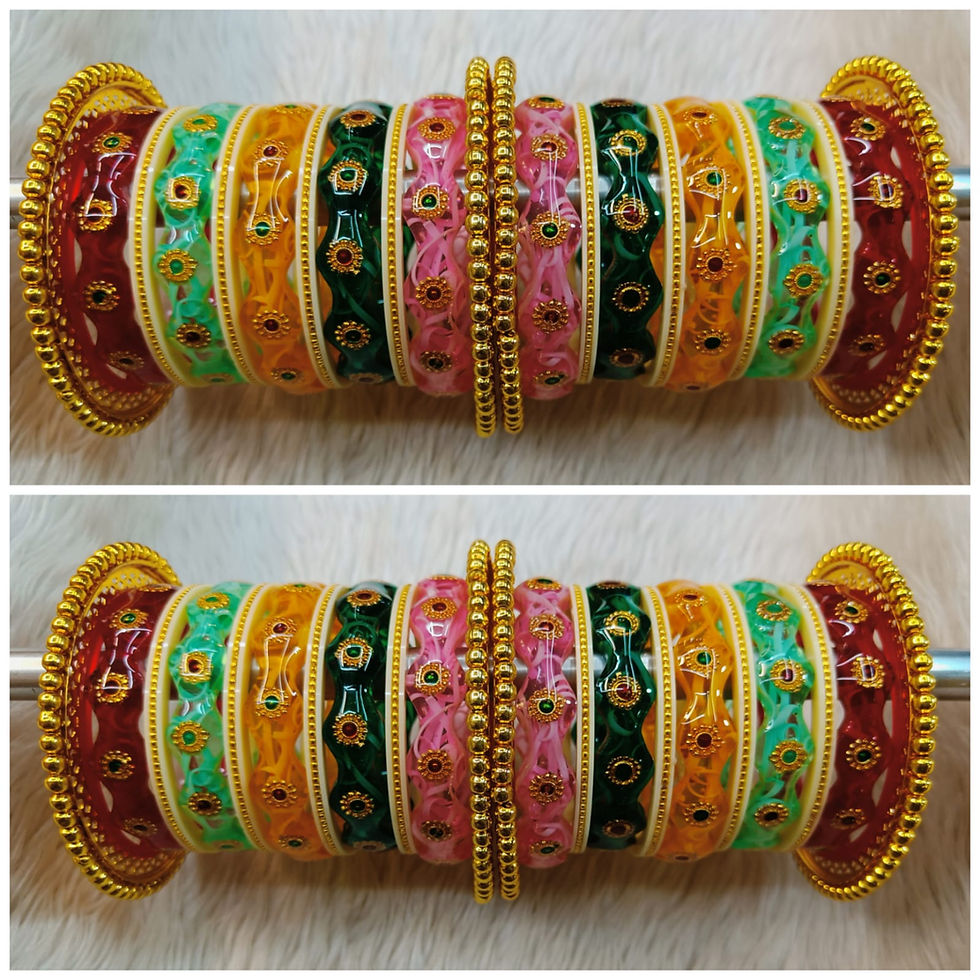Understanding the Significance of Wedding Chura in Indian Culture
- Vikram Singh
- Apr 20
- 4 min read
Weddings in India are a grand affair, steeped in tradition and rich in cultural significance. Among the myriad rituals and customs that define an Indian wedding, one of the most enchanting and symbolic elements is the wedding chura. This traditional adornment holds immense importance for brides, representing not just beauty but also cultural heritage, marital bliss, and the transition into a new phase of life. In this blog, we will explore the significance, styles, rituals, and care associated with wedding chura, delving deep into its importance in Indian weddings.

The Origin of Wedding Chura
The chura, a set of bangles traditionally worn by brides, has its origins in the Punjabi culture but has spread across various regions of India, each adding its unique touch to this beautiful custom. The word "chura" is derived from the Punjabi language, where it means "bangle." Traditionally, the chura is made from red and white lac, symbolizing prosperity and purity. The colors are believed to ward off evil and bring good fortune to the newlyweds. In many communities, the chura is gifted to the bride by her maternal uncle and aunt during a ceremony known as the "chura ceremony." This ritual is not just a formality; it serves as a blessing from the bride's family for a happy and prosperous married life.
Symbolism of the Chura
The wedding chura is more than just an accessory; it carries deep symbolic meanings:
Fertility and Prosperity: The colors red and white represent fertility and prosperity, which are essential for a successful marriage.
Protection: The chura is believed to protect the bride from negative energies and evil spirits.
Marital Status: Wearing the chura signifies that the woman is married, and it is a visual representation of her new status in society.
Cultural Identity: The design and style of the chura can vary significantly across regions, showcasing the rich cultural diversity of India.
Types of Wedding Chura
The chura comes in various styles and designs, influenced by regional traditions and personal preferences. Here are some popular types of wedding chura:
1. Traditional Lac Chura
This is the most common type of chura, made from lacquered wood. The traditional red and white colors are predominant, and intricate designs may be painted or engraved on the surface.
2. Gold Chura
For those who prefer a more luxurious option, gold churas are a popular choice. These are often made of 22K gold and can include intricate designs, gemstones, and engravings.
3. Kundan Chura
Kundan churas are adorned with precious and semi-precious stones, giving them a royal look. They are often worn by brides who want to make a statement with their wedding jewelry.
4. Glass Chura
Glass churas are vibrant and colorful, often featuring a mix of different colors. They are lightweight and can be customized to match the bride’s outfit.
5. Thread Chura
A more contemporary style, thread churas are made with colorful threads and can be adorned with beads and other embellishments. They offer a modern twist to the traditional chura.
Rituals Associated with Wedding Chura

The chura holds a significant place in wedding rituals. Here are some key ceremonies associated with it:
1. Chura Ceremony
The chura ceremony is a pre-wedding ritual where the bride is gifted her chura by her maternal uncle and aunt. This ceremony is often accompanied by singing, dancing, and celebrations, marking the bride's transition into married life.
2. Wearing the Chura
On the wedding day, the bride wears the chura as part of her bridal attire. It is an essential component of her look, symbolizing her new status as a married woman.
3. Post-Wedding Rituals
After the wedding, the chura is typically worn for a specific period, which can vary by community. In some cultures, the bride is required to wear the chura for 40 days, while in others, it may be longer or shorter. This period is often seen as a time of adjustment to married life.
Care and Maintenance of Wedding Chura
Given its significance and the materials used, proper care of the wedding chura is essential to maintain its beauty and integrity.
Avoid Water: It is crucial to keep the chura away from water to prevent damage, especially if it is made of lacquer or glass.
Store Properly: When not in use, store the chura in a soft cloth or a jewelry box to protect it from scratches and dust.
Regular Cleaning: Use a soft, dry cloth to clean the chura regularly to keep it shiny and free from dirt.
Avoid Harsh Chemicals: When cleaning, avoid using harsh chemicals or abrasive materials that can damage the surface.
Modern Trends in Wedding Chura
As weddings evolve, so do the trends surrounding the chura. Modern brides are increasingly opting for personalized and customized churas that reflect their individual styles. Here are some of the modern trends:
1. Customization
Brides are now choosing to customize their chura with unique colors, designs, and materials that align with their wedding theme and personal style.
2. Fusion Styles
Many brides are blending traditional chura styles with contemporary designs, incorporating elements like minimalistic designs or mixed materials for a modern touch.
3. Eco-Friendly Options
With a growing emphasis on sustainability, eco-friendly churas made from biodegradable materials or recycled elements are gaining popularity among environmentally conscious brides.
Also Check:
The wedding chura is a beautiful and meaningful element of Indian weddings, symbolizing love, prosperity, and the transition into a new life. Its significance transcends mere aesthetics, embodying cultural traditions and familial blessings. As trends evolve, the chura continues to hold its place in the hearts of brides, serving as a cherished reminder of their special day and the journey ahead. Whether traditional or modern, the wedding chura remains a timeless accessory that adds to the beauty and joy of Indian weddings.




Comments